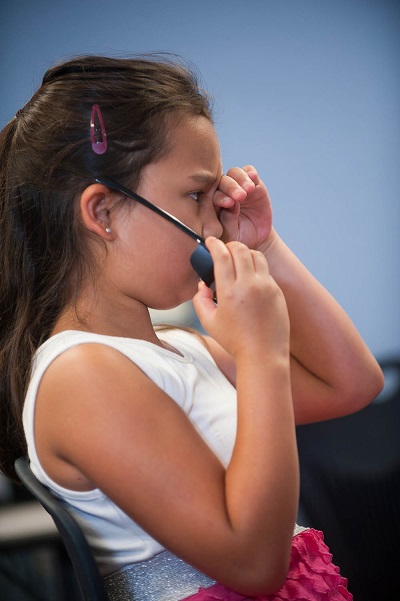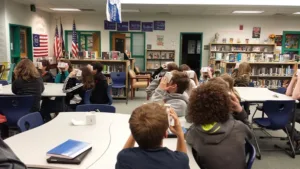Although the problem has not at all evaporated, one wonders why the press has recently gone silent on the “VR makes me sick” concern these days. The VR vision issue is still playing out in schools, for certain. Take this middle school classroom in Aurora, Colorado. Just last semester the class pictured below experienced their first virtual reality “field trip”.

6th and 7th graders in Aurora, Colorado
The lesson was remarkably successful, from an instructional point of view. However, at the end of the experience, the teacher reported that nearly every student reported being dizzy and “their eyes were tired or hurting for a while”. By the way, in educational circles, this is considered a very troubling outcome.
 Given the vision problems associated with virtual and augmented reality in schools, I went on a peculiar mission, not wanting the issue to go unchallenged due to the current lack of press coverage on the topic. So, at the ISTE 2017 conference, I informally polled what educators, vendors, and students actually know about this furtive health problem. (The ISTE 2017 educational technology conference held in late June, with over 15,000 educators in attendance, is considered the largest ed-tech conference in the U.S. Every state and more than 72 countries were represented at this year’s ed-tech extravaganza.)
Given the vision problems associated with virtual and augmented reality in schools, I went on a peculiar mission, not wanting the issue to go unchallenged due to the current lack of press coverage on the topic. So, at the ISTE 2017 conference, I informally polled what educators, vendors, and students actually know about this furtive health problem. (The ISTE 2017 educational technology conference held in late June, with over 15,000 educators in attendance, is considered the largest ed-tech conference in the U.S. Every state and more than 72 countries were represented at this year’s ed-tech extravaganza.)
Your intrepid reporter began by interviewing most of the VR exhibitors in the expo hall. The result: most were unaware of the vision challenges associated with student use of virtual reality, and all but a few really cared. (Gotta sell those widgets, y’know.) In fact, not a single vendor knew how to palliate these concerns in the classroom; nor how to spin this challenge in a positive way. The pat answer coming from vendors was “Don’t let those kids see VR in the classroom”. Uh-oh. That’s a clear non-starter in educational circles.
Next, your undaunted reporter questioned dozens of VR and AR-using teachers throughout the conference. The results were roughly the same, except one or two teachers grew irate, suggesting that there are no such problems. (Incidentally, these same educators admitted to this interviewer that they never bothered to ask the children how they were feeling/reacting to the classroom VR/AR.) And, of course, a few thoughtful educators made on-the-spot classroom adjustments, enabling children to rest their eyes or stay more stationary before rejoining the class activity. Affirming an apparent vendor-educator disconnect, not a single teacher would deny students the opportunity to view the VR/AR—they would just adjust time, position, or other exigent factors to make the best of the situation.
Finally, your spirited Display Daily reporter combed the conference for opportunities to talk to students who might be using VR at the conference. Eureka! Success! I found a group of students from Mexico who had integrated VR components into their studies and were there to present on their own accomplishments. These kids were smart, delightful, exuberant, and curious. (Oh, to be young again!) Hoping for greater clarity, I spoke entirely in Spanish to discover what these students knew about the vision challenges associated with VR in the classroom. Here’s what I learned from these lovely pupils:
- VR was well integrated in their studies.
- Of the ten students present, seven had no problems viewing or using VR.
- Three students of the ten could not view VR without getting sick. (One would not admit it until much later in our conversation.) These students were involved in the other aspects of this technology presentation, but did not use the virtual reality experiences themselves. (Surprisingly, they were there presenting alongside their compatriots, although they, themselves, could not enjoy any immersive experiences.)
- Students knew little about this issue, because…well…their teachers knew nothing about the issue.
Some of the talented students from Mexico City presenting at ISTE 2017
Student projects involved filming with 360 cameras and viewing the STEM content with VR headgear
Well, these numbers are about right, if perhaps a little high. Research indicates that around 14% of students worldwide cannot view VR comfortably. In careful Spanish, I explained to the students and teachers the medical reasons why they had these problems, and how they could reverse these circumstances, being mindful to convey a positive and hopeful message.
For now I must regrettably assign vendors, teachers and students alike a grade of D- for their ability to understand and deal with the vision problems of VR/AR use in the classroom. In next month’s installment, I will continue my unshrinking enquiry into the vision problems associated with student viewing of VR/AR, and end with a surprising and practical discovery that will give you even greater understanding and hope. Stay tuned…–Len Scrogan

